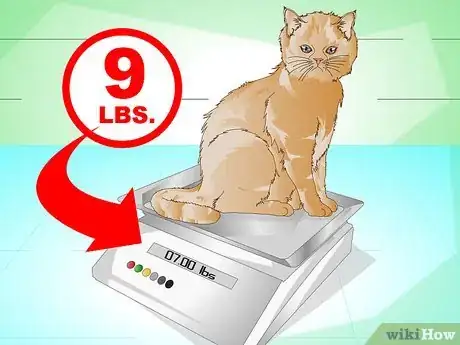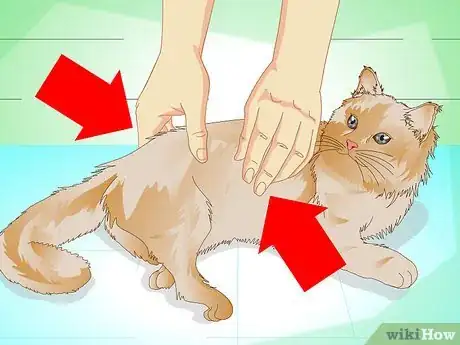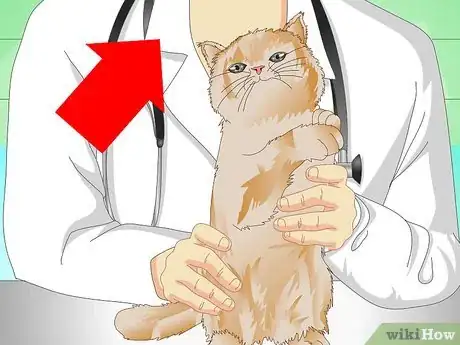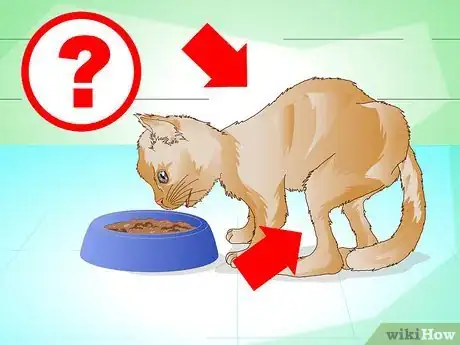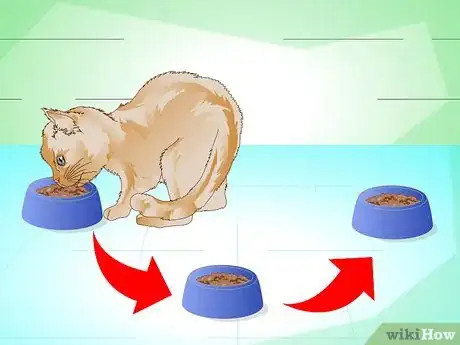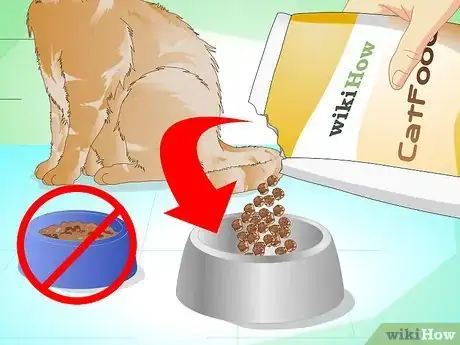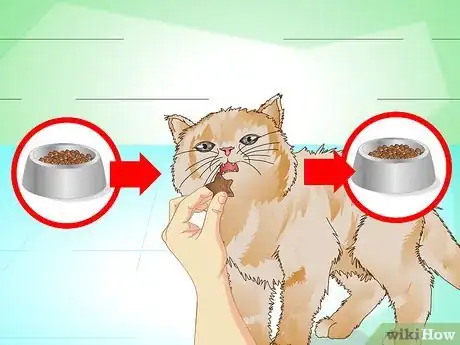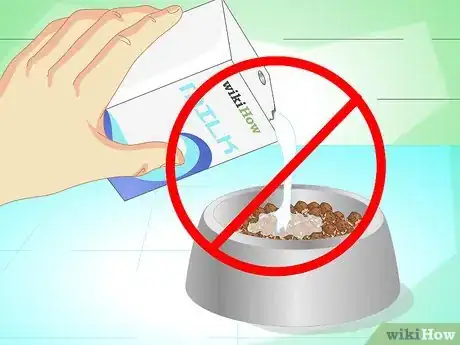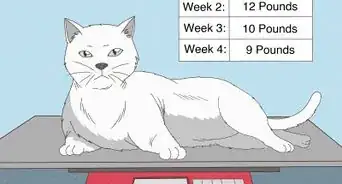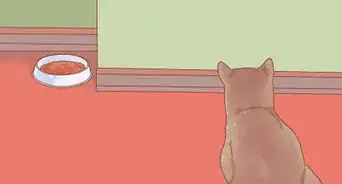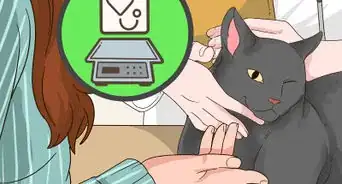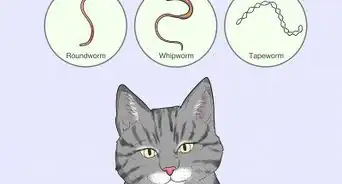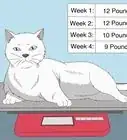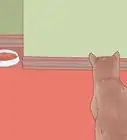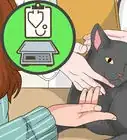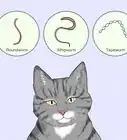This article was co-authored by Pippa Elliott, MRCVS. Dr. Elliott, BVMS, MRCVS is a veterinarian with over 30 years of experience in veterinary surgery and companion animal practice. She graduated from the University of Glasgow in 1987 with a degree in veterinary medicine and surgery. She has worked at the same animal clinic in her hometown for over 20 years.
wikiHow marks an article as reader-approved once it receives enough positive feedback. In this case, several readers have written to tell us that this article was helpful to them, earning it our reader-approved status.
This article has been viewed 128,643 times.
Is your cat looking a little skinny? If your cat seems to be under weight, the first thing to do is to get it checked out by its veterinarian. There could be a medical reason for the weight loss. It is important to identify any health problems before starting to increase the amount of food you give your cat, since some foods may can worsen certain diseases rather than help them. If you've seen the vet, and the vet has cleared your cat's health but also confirmed that the cat is underweight, then its time to increase the number and quality of the calories it gets.
Steps
Checking Your Cat's Health
-
1Know your cat's ideal weight. Have a target weight or body shape in mind. It is a common problem to overshoot the mark and turn a thin cat into a fat cat, which comes with a whole new set of health problems.
-
2Learn how to body score your cat. This will help you recognize when it reaches an ideal weight.[1] Body scoring is about feeling for your cat's ribs and backbone, to see how much fat covers the bones, and looking at the cat's body shape to recognize if it is over or under weight.
- The perfect cat should have ribs and a backbone that is easily felt, but without standing out through the fur. The cat should also have a slight waistline when viewed from above and the side, but without sharp angles.
- Healthy weight charts can easily be found online that illustrate and describe feline body scores, making it easier to analyze your cat's body.
- Alternatively your vet can weigh your cat and make an estimate of their desired target weight. Weigh the cat weekly at home and keep a record of its weigh-ins.
Advertisement -
3Take your cat to the vet. They can assess your cat's health and make suggestions for any necessary treatments. In addition, your vet can take care of routine deworming. If your cat is healthy but underweight, make sure it is dewormed against both roundworms and tapeworms. Be sure to check whatever product you use is effective against both sorts of worms. Some common products, such as Stronghold (UK) Revolution (US) and off the shelf products such as Hartz once-a-month wormers, work against roundworms but NOT tapeworms.
- Speak to your vet about a multi-wormer containing praziquantel, in order to kill tapeworms as well.
-
4Be aware that a greedy cat with a thin body indicates a problem. If your cat is older, runs around like a kitten, eats well, but is losing weight, be aware the cat may have a medical problem called hyperthyroidism. This involves the cat having high levels of thyroid hormone in the blood stream, which acts as a stimulant. The cat burns off calories quickly and eats loads to try and replace them. However, despite the cat's apparent good health, this stimulation puts pressure on the organs, including the heart and kidneys.
- Rather than trying to combat the problem by feeding the cat more, seek veterinary help and get the source problem corrected to preserve your pet's good health.[2]
- The vet might tell you that your cat has anorexia. This means that it lacks the desire to eat. In this case, they may tell you to water down canned food and give it to your cat using an oral syringe. Ask your vet if they think this approach would help your cat bridge the gap until it is in better health.
EXPERT TIPDr. Elliott, BVMS, MRCVS is a veterinarian with over 30 years of experience in veterinary surgery and companion animal practice. She graduated from the University of Glasgow in 1987 with a degree in veterinary medicine and surgery. She has worked at the same animal clinic in her hometown for over 20 years.Veterinarian
 Pippa Elliott, MRCVS
Pippa Elliott, MRCVS
VeterinarianPippa Elliott, a licensed veterinarian, advises: "It's important to get any underlying health problems diagnosed and treated. Merely feeding more food but not treating the cause of the weight loss can result in unwanted complications such as diarrhea."
Improving the Quality of Your Cat's Diet
-
1Assess the quality of your cat's diet. Cat digestion is designed to process a high protein diet. A food which contains a high proportion of cereal or non-animal protein is less than optimal and may be hard for your cat to digest, resulting in insufficient calories.[3]
- Read the label of your cat food. It should list a named meat as the first two or three ingredients, with cereals and vegetables way down the list. If cereals or soy are high up the list, switch foods.
-
2Speak to your vet about a high quality diet. Many premium supermarket foods are highly palatable, but are made so with the addition of flavorings and therefore not nutritionally ideal. Your vet should have some suggestions about what foods will be best for your cat.
- Raw food diets are high in water and nutrients. Ask if raw food would be a better choice for your pet. You can buy raw food at pet stores, online, or make at home. Be very careful that your raw food is nutritionally complete or you may end up damaging your cat's health.
- A good indicator of quality is to chose a manufacturer who also creates prescription diets for the veterinary market, because their knowledge of treating ill health through diet could also cross-pollinates into their regular cat foods.
- Royal Canin and Hill's are examples of over the counter foods that also manufacture prescription food.
-
3Consider competition between cats. If your have several cats be careful to observe the dynamics between the cats and make sure the thin cat is not being bullied or kept away from the food bowl. Make sure each cat has its own food bowl, and be sure to place the food bowls at opposite ends of a room, or even in separate rooms. This makes it harder to a dominant cat to patrol the food area and prevent other cats getting access.
- If you have a greedy cat that eats everyone else's portions, consider getting a microchip activated food bowl. These devices have a locked lid which is only opened when the cat approaches whose microchip bears the number programmed into the dish.
Increasing the Amount You Feed Your Cat
-
1Increase the frequency of feeding. Most cats would rather graze throughout the day, rather than gorging themselves all at once. With this in mind, feed the cat more frequently, rather than offering larger meals.
- This is more in tune with the cat's natural digestive processes and its more likely to finish a small bowl of food than a large one.
-
2Increase the calorie content of the food. Canned food has a high moisture content (around 70-75% is water) so an easy way of getting more calories into a cat is to switch to dry kibble (provided kitty is happy to eat dry food). The lower moisture content means that for each mouthful of food eaten the cat is taking in nearly four times as many calories.[4]
- Consider offering a highly palatable, calorie dense food. Hills AD is a recovery diet made to put weight on cats that are convalescing after an illness. It is liver based and ultra tasty for many cats, as well as being calorie dense. It's soft pate like texture also encourages cats to eat who have sore mouths, or are otherwise feeling delicate.
-
3Consider giving your cat treats between meals. Treats are usually tasty, which means high calorie, and attractive to most cats. However, be careful not to dull the cat's appetite when it comes to mealtimes.[5]
-
4Be careful what you add to food. For example, be careful if you decide to increase your cat's calorie intake by giving cream or milk. The cream has a high fat content that can trigger diarrhea, which will then cause your cat to lose precious calories. Milk contains lactose which many cats are unable to digest and will therefore also give the cat diarrhea.[6]
-
5Reassess your feeding schedule once the cat reaches its target weight. Stop feeding for weight gain and start on a maintenance food. Weigh out the ration and give the amount recommended on the package for a cat of that weight.
References
- ↑ https://www.purina.co.uk/cats/health-and-nutrition/exercise-and-weight-management/purina-body-condition-tool
- ↑ Small Animal Internal Medicine. Nelson and Couto. Publisher: Mosby.
- ↑ http://pets.thenest.com/promote-weight-gain-cats-7243.html
- ↑ Small Animal Nutrition. Agar. Publisher: Butterworth-Heinneman
- ↑ http://pets.thenest.com/promote-weight-gain-cats-7243.html
- ↑ Small Animal Internal Medicine. Nelson and Couto. Publisher: Mosby.
About This Article
To put weight on a cat, make sure that you take it to the vet beforehand to rule out any underlying health problems, like hyperthyroidism. If your cat is healthy but underweight, have your vet recommend an ideal target weight for your cat. Next, choose a high quality, calorie dense cat food, such as Hills AD, and increase how often you feed your cat. Additionally, consider giving your cat treats in between meals for an extra boost of calories. Then, weigh your cat once a week to monitor its progress. For more tips from our Veterinary co-author, like how to deal with competition for food between your cats, read on!
